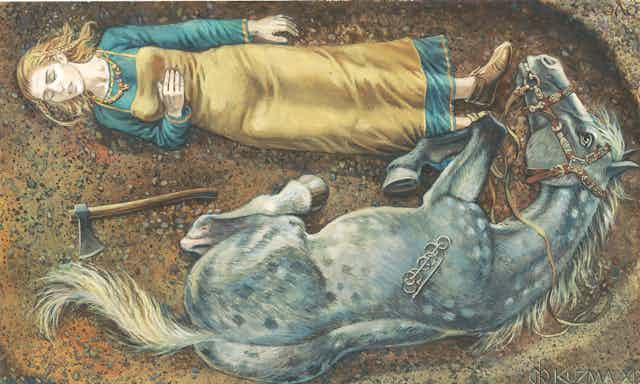Is your pet part of the family? That’s nothing new. Archeological evidence exists to suggest that the vikings held their own animals in high – even intimate – regard, taking them with them on voyages. Earlier this year, scientific evidence found for the first time that – as early as the ninth century – vikings brought horses, dogs and other animals with them across the North Sea.
The prevailing assumption had been that enterprising viking armies had simply acquired horses (along with other items of plunder) in their raids on the British Isles. But these findings suggest that the depth of the relationships viking-age people had with animals have been dramatically underrepresented.
But why? After all, the vast majority of people – Scandinavian or otherwise – living through the viking age relied on farming to survive. Why has it taken so long for researchers to realise that these humans and animals sustained deep, complex, emotional and mutually enriching relationships?
Past societies cared about humans, animals and things differently. Some humans could be owned, even viewed as objects and valued far less than some animals. In our research, we use both archaeology and texts to show that some horses in communities such as those of viking-age Scandinavia and Iceland could be seen as “people” themselves, capable of agency and worthy of careful and deliberate treatment.
Horses in human graves
Horses in the viking age were seen as liminal creatures, meaning they were capable of crossing physical and conceptual boundaries, travelling over different terrains, and even between worlds. They also held cosmological significance.
Norse poetry depicts the god Odin riding to the land of the dead on his eight-legged horse Sleipnir. A newly-discovered bracteate – or pendant – bearing a runic inscription from Denmark might also suggest an association between Odin (or at least someone who identifies himself as “Odin’s man”) and a horse companion as far back as the early fifth century AD.
Read more: Is Norse god Odin older than previously thought? An expert analyses new evidence
Historically, horse bodies in viking-age burials have been interpreted as symbolic of the journey to the afterlife, part of the possessions of the deceased in the afterlife, or as status symbols. But these interpretations miss something vital – the bond between horse and rider.
Horses have special relationships with their riders, as both have to learn to work with each other. In Norse poetry (some of which links to the viking age) horses were a vital part of warrior identities. Legendary poems about the heroes Helgi and Sigurd depict heroes who are almost inseparable from their horse companions. Grani, the horse of Sigurd the dragon-slayer for example, is depicted mourning Sigurd after his death.
Evidence of partnerships between humans and horses has been found in burials from across northern Europe, from the grand ship burials of Ladby and Gokstad, to the equestrian burials of tenth-century Denmark, to the more modest human-horse burials in viking-age Iceland. But horses weren’t just buried with men.

At Trekroner-Grydehøj in Sjælland, Denmark, a woman was buried with a horse next to her, one leg partially overlapping with the human body (above). Something about this human and this horse meant such an intimate arrangement was appropriate.
The woman is thought to have been a ritual specialist, possibly a sorceress, buried with an iron-tipped copper rod and a range of other objects including some knives, a bucket and a small wooden box. A large flat stone, a dog which had been cut in half and some sheep bones, as well as some iron pins (possibly for fastening baggage to a saddle) and a dog chain completed the burial.
At Løve in Vestfold, Norway, a tenth-century burial also has a horse laid next to a woman. Like the woman at Trekroner-Grydehøj, they are thought to have been a ritual specialist. But the woman wasn’t the only one buried with the tools of her trade. An iron rangle (a metal ring with smaller rings attached to it) was laid on the chest of the horse buried alongside her. When attached to wagon harnesses or bridles, the metal rings would jingle. It is thought that it may have played a role in viking-age rituals.
Were these women buried with these horses because they had special relationships? Or because they were sorceresses? Or did being a sorceress entail close relationships with these animals? We believe that, among other rituals, horses appear to have been vital participants in the processes and practices of funerals.
Good to die with, good to live with
Research shows that relationships with horses have a host of benefits, especially for young people. It’s interesting then, that there is a repeated insistence in Norse poetry and medieval sagas that young men should practise horse grooming and training. Horses are considered partners in farming and often even members of families in these texts.
The 13th-century saga Bjarnar Saga Hítdœlakappa even depicts a woman who appears to benefit from a medieval form of equine-assisted therapy, finding relief from her ailment by sitting on her horse as it is led around a field:
The most relief was offered to her by sitting on horseback, as Þórðr led her horse back and forth, and he did so, even though it was a great pain to him, as he wanted to try to comfort her.
In a time of ecological upheaval, looking to the past to understand the relationships humans have had with animals can inspire different approaches to the present and the future. Given a recent victory by Māori activists granting legal personhood and rights to a river, looking for historical analogies, such as the vikings and their horses, can encourage us all to continue to push for more responsible relationships with the non-human world.

Looking for something good? Cut through the noise with a carefully curated selection of the latest releases, live events and exhibitions, straight to your inbox every fortnight, on Fridays. Sign up here.

